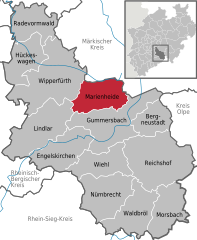Marienheide
| Marienheide | ||
|---|---|---|
|
||
| Coordinates: 51°5′N 7°32′E / 51.083°N 7.533°ECoordinates: 51°5′N 7°32′E / 51.083°N 7.533°E | ||
| Country | Germany | |
| State | North Rhine-Westphalia | |
| Admin. region | Köln | |
| District | Oberbergischer Kreis | |
| Government | ||
| • Mayor | Uwe Töpfer (SPD) | |
| Area | ||
| • Total | 54.99 km2 (21.23 sq mi) | |
| Elevation | 256 - 506 m (−1,400 ft) | |
| Population (2015-12-31) | ||
| • Total | 13,560 | |
| • Density | 250/km2 (640/sq mi) | |
| Time zone | CET/CEST (UTC+1/+2) | |
| Postal codes | 51709, 51704–51706 | |
| Dialling codes | 0 22 64 | |
| Vehicle registration | GM | |
Marienheide is a municipality in the Oberbergischer Kreis, in North Rhine-Westphalia, Germany.
Marienheide is located about 50 km east of Cologne.
The neighbouring towns are Gummersbach and Wipperfürth as well as in Märkischer Kreis - Meinerzhagen and Kierspe, and the neighbouring municipalities are Engelskirchen and Lindlar.
The first documentary mention of the place was in 1417 " in a sales document is called Heydenreich of our dear Mrs. Knecht on the Mergenheyde " (Documentary first namings of oberbergischer places v. Klaus Pampus).
The manner of writing of the first naming was: Mergenheyde.
On the altar lights of the old pilgrimage church a signed coat of arms of 1601 which carries the name "Mergenheyd" is to be seen. An old brochure of the Catholic vicarage Marienheide states: " The origin of the mercy place Marienheide dates back to 1420 and to one particular man. " This person, a simple man called Heinrich, lived as a hermit in a hit rock hiding place in the " Bockelsburger Wood ", near the present-day railroad line. The hermit apparently lived from agriculture. Another chronicle, not described further, is stated as a source, and thus one says further that " the mother of God appeared to this keen Heinrich in the form of a small picture and ordered to him to proceed to Cologne to purchase a similar little picture for thirty pieces of silver. " With this the foundation for the place of pilgrimage was laid. Hermit Heinrich has been found with Count Gerhard of the Mark, the sovereign at that time, support, so that Pope Martin V as well as the preacher's order interested. Thus was built "in the wilderness" the first little church and, a little way away, the Dominican order's cloister.
...
Wikipedia




